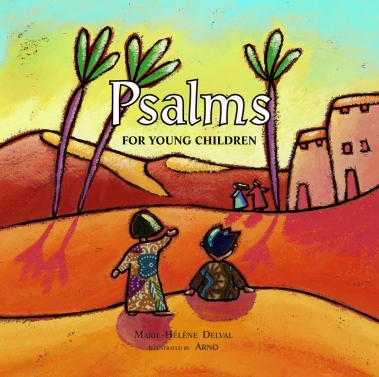Psalm 23. One of the first bits of Scripture many of us learned. One of the few Bible passages most people still recognise and find comforting. The theme tune for The Vicar of Dibley.
It’s worth breaking out of the Bible STORY mold occasionally and introducing children to the other parts of the Bible – primarily the poetry and prophecy. This has several benefits – first of all, the rich imagery of these passages can be very meaningful to children, and secondly, it plants the idea, early on, that the Bible is a complex book full of many genres of writing.
Here are a few of my favourite Bible books that can help do this, starting with two retellings of the classic 23rd Psalm.

FOUND, by Sally Lloyd-Jones, illustrations by Jago.
Simple text and beautiful illustrations remind children of God’s enduring love and care. A perfect book to read aloud at bedtime, give as a baptism gift, or have in your church creche/children’s corner. You can also use it as the story in Junior Church for an under-5s group. (We have a copy of this in the Resource Centre if you’d like to borrow it.)
 PSALM 23, illustrated by Barry Moser.
PSALM 23, illustrated by Barry Moser.
This one was available in the UK when I bought it for my church, but doesn’t seem to be now. It’s worth keeping an eye out for, however, as it uses the Biblical text and the illustrations have lots of details that can start discussions with children about what the psalm means and how they feel about it.
The imagery – a modern-day child like them, in a T-shirt, and other details – helps ground the psalm’s reassurances in a world familiar to children.
PSALMS FOR YOUNG CHILDREN, and IMAGES OF GOD, both by Marie-Helene Delval and illustrated by Arno.
These books have a simple format – a line or two of Scripture on one side of each spread, and a beautiful illustration on the other to bring it to life. The text is accessible even to toddlers, without diminishing the richness of it, and each page has a Biblical reference, so parents and older children can look up the original line and its context. These are also in our Resource Centre.
 For older children, the LION GRAPHIC BIBLE, by Jeff Anderson and Mike Maddox, is very good at showing how the prophecy and poetry came to be written, and when in the story of God’s people the different parts of it appear. You see the Babylonian exile, and then you read the psalms written at that time, and hear the words of the prophets. It’s a very good introduction to some of the story of how the Bible came to be, and how the poems and prophesies fit into the whole. (Bear in mind I haven’t read all of this book, so there may be glaring problems with it I haven’t caught. But I’ve used parts of it with small groups and it’s all been good so far.) Again, we have a copy of this in the Resource Centre, so do borrow it.
For older children, the LION GRAPHIC BIBLE, by Jeff Anderson and Mike Maddox, is very good at showing how the prophecy and poetry came to be written, and when in the story of God’s people the different parts of it appear. You see the Babylonian exile, and then you read the psalms written at that time, and hear the words of the prophets. It’s a very good introduction to some of the story of how the Bible came to be, and how the poems and prophesies fit into the whole. (Bear in mind I haven’t read all of this book, so there may be glaring problems with it I haven’t caught. But I’ve used parts of it with small groups and it’s all been good so far.) Again, we have a copy of this in the Resource Centre, so do borrow it.
What books have I missed? Add your recommendations in the comments!











